|
Plasma
The
Electric Universe
Science
and Philosophy
Ancient
Testimony
Mythology
Catastrophism
Plasma Mythology
Peratt & Petroglyphs
Cutting
Edge
The
Way Forward
Latest
News
Video
|
 |
|
 |
 |
| "I would rather have
questions that can't be answered than
answers that can't be questioned." Richard
Feynman |
|
|
| |
|
|
| Ancient
Testimony |
|
|
| |
|
|
| Mythology |
|
|
| |
|
|
|

The famous auroral
Dragon
photographed in 2019
|
|
"Are all these legends a
confused account of great events on a
planetary scale which were beheld in
terror simultaneously by men scattered
everywhere over the world?" Anonymous
Editor, Larousse Encyclopedia of Mythology
|
| |
|
|
"But when the
planets in evil mixture to disorder
wander,
What plagues and what portents, what
mutiny,
What raging of the sea, shaking of
earth,
Commotion in the winds!"
William
Shakespeare
Modern scholars generally define myth as
a form of sacred history which attempts to
describe the origin of the world and
various cultural institutions. If, as
seems to be the case, myth also preserves
clues for reconstructing the recent
history of our solar system, its study
becomes all the more important.
Comparative mythology highlights striking
cross-cultural similarities which strongly
suggest the core of most if not all
ancient mythology has planetary origins.
This begs the question: How is it that
planets which appear as mere tiny specks
in the night sky could have held such a
profound fascination for our ancestors?
"All the
stories, characters, and adventures
narrated by mythology concentrate on
the active powers among the stars,
who are the planets."
Giorlgio de
Santilla, Hertha von Dechend, Hamlet's
Mill
According to the prevailing dogma, the
Nebular Hypothesis, planets and stars
accreted from the dust cloud after the Big
Bang billions of years ago. In this
dubious model it is assumed that these
bodies have occupied more-or-less steady
and unchanging orbits ever since. Anyone
who challenges this ideological assumption
is quickly reminded of the 'fact' that the
only forces at work are gravity and
inertia. Any contrary viewpoint thus
requires 'mysterious' forces. As it turns
out, though, these forces are not so
mysterious, after all.
The Plasma Universe permits many ideas
that are dismissed by establishment
science. When the role of plasma and
electromagnetism is acknowledged, this
broader perspective allows us to view
mythology with less comtempt. Is so much
ancient myth merely the work of ignorant,
superstitious savages, or do our ancestors
have something more profound to tell us?
Did they view skies very different from
what we see today, and witness
catastrophic events and spectacular
discharge phenomena? (The Thunderbolts of
the Gods.) Phenomena that make today's
auroras and natural disasters look trivial
by comparison!
"...A
'derivation' of the sword from a
'root' or archetype in lightning is
universal and world wide."
Ananada Coormaraswamy
So many bizarre mythological details
don't make any sense in the real world,
such as flying and fire-breathing dragons,
differing planetary orbits and
configurations, and countless others. It
is easy to dismiss them as the product of
creative imagination, but this attitude
runs up against an insuperable difficulty
— these seemingly impossible motifs can be
found the world over. It is very difficult
to understand how creative imagination
could explain such consistent and
recurring motifs, as a number of leading
anthropologists, classicists, historians,
and mythologists have acknowledged. It is
therefore important to recognise the
patterns and key points of agreement
across cultures.
"...The extreme
preoccupation of most early
societies with celestial
imagery...appears to be part of a
world wide phenomenon."
Mark Bailey, astronomer, Armagh
Observatory
|
|

|
| Saturn |
|
|
| |
|
|
|
Saturn appears to
play perhaps the most important role in
ancient mythology, that of the central
luminary of the sky. This begs the
following questions:
Why did the early
astronomers celebrate the planet Saturn as
the first Supreme God? Why did the
ancients sacrifice their children to
Saturn? Why was the original Sabbath, the
most sacred day of the week, named after
Saturn? Why did ancient nations invoke
Saturn as the primeval Sun? Why did early
astronomers declare that Saturn ruled from
the celestial pole? Why do so many modern
religions carry remnants of Saturn
worship?
Dwardu Cardona's book
series, beginning with God Star,
is a comprehensive and fascinating look at
Saturn mythology.
"What
has Saturn, the far-out planet, to
do with the Pole? Such figures of
speech were an essential part of the
technical idiom of archaic
astrology."
Giorlgio de Santilla,
Hertha von Dechend, Hamlet's Mill
How do we begin to explain
the Saturnian ring symbolism that pervades
our cultures? For example:
The Halo of the
saints
The Royal Crowns
The ring on the finger given in
marriage
Circled crosses. Both the Celtic cross
and Egyptian ankh, for example
The Eye of Ra
The astronomically baffling star
inside the crescent
All of the above symbols
have been identified as Saturnian in
origin, and they still haunt our modern
world. Many
contemporary festivals contain similar
vestiges. Christmas celebrations, for
example, bear more than a passing
resemblance to the Roman Saturnalia, which
was held in mid December. It was a
hedonistic time when food and drink were
plentiful.
"When Saturn
ruled the skies alone
(That golden age, to gold unknown,)
This earthly globe to thee assign'd
Receiv'd the gifts of all mankind."
Johnathan Swift, A
Panegyric on the Dean
The black square is also
identified as a Saturnian symbol. See below.
The Kaaba at Mecca,
Islam's holiest site, is a large black
cube. Wherever they are in the world,
Muslims are expected to face the Kaaba
when performing the Islamic prayer, Salah.
In Judaism, Tefillin or
phylacteries are a set of
small black boxes which contain scrolls of
parchment inscribed with verses from the
Torah. In Rabbinic Judasim, the
predominant form of Judaism today,
tefillin are worn by adult Jews during
weekday morning prayers. In orthodox
communities they are worn only by men. In
academic circles, students will often
sport a square black head-dress during
graduation.
The isotopic ratios of
water on Saturn and Earth turn out to be
almost identical! This is a big surprise.
Was planet Earth once a satellite of
Saturn? The Altlantic Ocean was once known
as the sea of Kronos.
"By
developing a new method for
measuring isotopic ratios of water
and carbon dioxide remotely,
scientists have found that the water
in Saturn's rings and satellites is
unexpectedly like water on the
Earth.
"The
results, found in the Icarus paper
'Isotopic Ratios of Saturn's Rings
and Satellites: Implications for the
Origin of Water and Phoebe' by
Planetary Science Institute Senior
Scientist Roger N. Clark, also mean
we need to change models of the
formation of the Solar System
because the new results are in
conflict with existing models."
Phys.org
Was Tolkien's famous book The
Lord of the Rings a reference to
Saturn?
“And some things that
should not have been forgotten were
lost. History became legend. Legend
became myth.“
JRR Tolkien
|
|


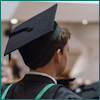
|
|
The Saturn
Theory by comparative mythologist Ev
Cochrane of maverickscience.com. From the
paper:
"The Saturn theory,
in addition to presenting a
comprehensive model of ancient myth,
offers a radically different approach
to understanding the recent history of
the solar system. Briefly summarized,
the theory posits that the neighboring
planets only recently settled into
their current orbits, the Earth
formerly being involved in a unique
planetary configuration of sorts
together with Saturn, Venus, and Mars.
As the terrestrial skywatcher looked
upwards, he saw a spectacular and
awe-inspiring apparition dominating
the celestial landscape. At the heart
of heaven the massive gas giant Saturn
appeared fixed atop the North polar
axis, with Venus and Mars set within
its center like two concentric orbs
(see image, right, where Venus is the
green orb and Mars the innermost red
orb). The theory holds that the origin
of ancient myth and religion—indeed
the origin of the primary institutions
of civilization itself—is inextricably
linked to the numinous appearance and
evolutionary history of this unique
congregation of planets."
|
|
 |
 |
|
An
artist's impression of the Polar
Configuration viewed in ancient skies,
left, with Saturn as the backdrop, Venus
middle, and Mars, front. |
| |
|
|
| Paradise Lost |
|
|
| |
|
|
|
Before the Electric
Universe merged with David Talbott's
recreation of mythic themes, Talbott noted
that today's world does not answer to the
ancient world. The video below from 1996,
Remembering the End of The World,
explores the Saturn model before plasma
and electromagnetism provided an
explanation for the celestial mechanics.
Remembering
The End of The World
The broader perspective offered post
merger in Symbols of an Alien Sky
includes an electrified cosmic environment
and high energy electrical events. Both
videos enjoy Talbott's captivating
narration.
Symbols of
an Alien Sky
In Remembering the End of The World
(at around 45 minutes), Talbott reflects
on the role of Saturn as the backdrop to
the cosmic drama. One part of his summary
goes something like this: A worldwide
tradition says that before a king ever
ruled on Earth, a prototype of kings arose
in heaven — the father of kings or
universal monarch. This was the model of
the good king. For example, the Hindu
Brahma, the Aztec Quetzacoatl, and the
Egyptian Ra. In the epic era known as the
golden age, this good king brought about
abundance. The Chinese called it the age
of Perfect Virtue, the Iranians called it
the age of the Brilliant Yima, The Danish,
Peace of Frodi, and so on. It was paradise
on Earth, or the Purple Dawn. The
Garden of Eden. It is impossible to
overstate the power of this memory among
different cultures. Saturn was the
founding king of the Golden Age, and most
cultures pay tribute to it with their
original Sabbath or Saturn day (Saturday).
Even today our language retains the age
old cultural ambivalence toward this most
ancient god. The word Saturnian expresses
the splendour and munificence of the
Golden Age, while the word Saturnine
(morose, gloomy) reflects the melancholy
of Paradise Lost.
Interestingly, after the
death of Her Royal Majesty Queen Elizabeth
II on 8th September 2022, in a speech
before the House, former UK prime minister
Boris Johnson paid tribute to her
'unvarying Polestar Radiance'. Twitter
link (from 1:15).
|
|

Another artist's impression of the Polar
Configuration, offset.
|
| |
|
|
| A Different Sun? |
|
|
| |
|
|
|
Ancient Babylonians were careful to
distinguish Shamash, their ancient Sun
god, from our current Sun, identifying it
with the distant planet Saturn. This led
Velikovsky to consider the possibility
that Saturn once loomed much larger in the
sky ... perhaps as a sunlike body over
satellite Earth!
The Popol Vuh, considered the 'Mayan
Bible', also attests to this:
"Like a man was
the sun when it showed itself … It
showed itself when it was born and
remained fixed in the sky like a
mirror. Certainly it was not the
same sun which we see, it is said in
their old tales."
D Goetz & S. Morley, Popul Vuh
(Norman 1972)
Sol, Helios, and Kronos were actually
names for the first or old Sun. Many
cultures were careful to differentiate it
as the Best Sun, Superior Sun, or
Exemplary Sun, which ruled from the axis
of the sky around which the heavens
turned.
"Helios and Kronos
were one and the same God."
Franz Boll,
Classicist
As bizarre as the above may sound to the
uninitiated, the Saturn theory actually
suffers from an embarrassment of riches.
Early descriptions of the 'Sun' and
various planets from Mesopotamia and
elsewhere describe them as occupying
positions not possible within current
astronomical thinking.
For the Egyptians, Atum was was the
primeval sun, who ruled from the center
and summit of the sky.
"The great god lives,
fixed in the middle of the sky."
Egyptian Coffin
texts.
As part of the evolution of what is known
as the Polar Configuration, Venus assumed
a radiant appearance. Streams of luminous
plasma formed a flower like pattern across
the face of the ancient sun-god. Artists
impressions, above right and top right.
With the white background, the Mespotamian
Shamash from Wikipedia, is pictured right.
The 'cosmic wheel' and many other
identical symbols are common across
numerous ancient cultures. The cosmic
wheel is occasionally dismissed as a crude
representation of our current sun,
although this approach fails to account
for the bodies depicted in front of it,
among numerous other anomalies.
|
|

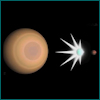
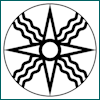
|
| |
|
|
| Venus |
|
|
| |
|
|
|
The planet Venus also plays an important
role in ancient mythology. Converging
images include the Babylonian 'torch' and
'bearded star', the Mexican 'smoking
star', the Peruvian 'long-haired' star,
the Egyptian Great Star 'scattering its
flame in fire', and further widespread
imagery from around the globe - that of
Venus as a flaming serpent or dragon in
the sky.
Venus is often portrayed with a dual nature—radiant yet destructive. In Greek mythology, this paradox appears vividly: the planet is linked both to Aphrodite, the golden-haired goddess of love and beauty, and to Medusa, whose serpent-crowned head embodies terror and ruin.
Venus has also been called both the
Morning and Evening Star, and Lucifer, the
Bringer of Light or Shining One, from the
Latin lux 'light'
and ferre 'to bear or
bring'. If Venus arrived in our solar
system as a comet, or if it fell out of
alignment with some previous planetary
configuration, perhaps this might begin to
explain the fallen angel legends.
Originally thought to be a twin of the
Earth, of course, Venus turns out to have
a very hot and gaseous atmosphere rich in
hyrdocarbons, as Immanuel Velikovsky
successfully predicted. This is not the
first controversy to fall in his favour.
"How you have fallen
from heaven,
O morning star, son of the dawn!
You have been cast down to the earth,
you who once laid low the nations!"
Isaiah 14:12, Old
Testament
"Quomodo cecidisti de
caelo,
Lucifer, fili
aurorae?
Deiectus es in terram,
qui deiciebas gentes."
From the latin
Vulgate
Venus is also the only planet to rotate
counter-clockwise in our solar system.
Because the Sun played an important role
in older religions, it was considered bad
luck to go against its clockwise motion,
and anti-clockwise rotations were
sometimes referred to as widdershins from
the old German weddersinnes,
literally 'against the way'.
The comet theory also has it that Venus
took some time to settle into its current
planetary orbit. In a number of old
traditions anti-clockwise rotations are
not unusual. Eastern Orthodox Christians
generally circle a church in this
direction, and in Judaism a bride may
circle her groom seven times
counter-clockwise before marriage. There
are similar traditions in a number of
Eastern religions. Could these be vestiges
of Venus adoration?
In Hindu mythology, similarities between
Kali and Venus jump out. Kali also
displays a dual nature, both beautiful and
destructive, sexual and violent, motherly
but malevolent, much like Aphrodite and
Medusa in Greek mythology.
In Mesoamerica, Quetzacoatl, the
feathered serpent deity, was identified as
Venus, and typically depicted as green in
colour. The Quetzal bird of South America
enjoys beautiful green plumage.
"He
set himself on fire ... and when the
ashes were extinguished, then arose
his heart, the quetzal bird itself:
they saw it. And so he knew they had
entered the sky...The old ones used to
say that he was transformed into the
dawn star."
Anales de Cuauhtitlan 11
|
|



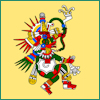
|
| Mars |
|
|
| |
|
|
|
The planet Mars, of course, is associated
with war, and the month of March is named
after it. He was the fearless warrior who
wielded thunderbolts, and he is venerated
by many differing cultures across the
globe, where the themes vary little.
Consider the following parallels:
'Scarface' was the name of a legendary
Blackfoot Indian warrior, also called
'Star Boy'. The Pawnee warrior, Morning
Star, can also be identified as the planet
Mars. Greek mythology describes various
heroes and rogues being struck down by a
thunderbolt. For example, when Ares, the
planet Mars, was wounded in battle, he
roared with the din of a thousand warriors
and rushed to Zeus to show off his scars.
Hindu myths also speak of a deep scar on
the head of the warrior Indra, their god
of the cosmic thunderbolt.
Pictured right is the Aztec god Xipe,
sporting a scarred face.
"The space
between two planets lights up and is
set aflame by both planets and
produces a train of fire."
Seneca, Roman
naturalist
Video link:
Symbols of
an Alien Sky Episode 2 - The
Lightning-Scarred Planet Mars
|
|
|
| |
|
|
| The Moon in
myth |
|
|
| |
|
|
|
The moon
is mysterious. Relevant to this
particular page is the fact that the
further you go back in time the fewer
mentions of it there are to be found,
although numerous accounts speak of a sky
'before the moon arrived'. The Proselenes
of Arcadia, for example, claimed to have
been around before there was a 'moon in
the heavens' and, on the other side of the
earth, the ancient Tiwinaku culture of
Bolivia refer to a time when there was no
'moon in the sky', claiming it arrived
around 12,000 years ago. Zulu legends also
have it that our Moon was a spaceship
moved here by reptilian beings. See conspiracy theories
below for a mythological perspective on
dragon and serpent symbology.
"As far as science is
concerned, the Moon should not be
there! It's too large, too light, and
its density reveals no substantial
iron core. It's older than the Earth,
apparently, with no natural
explanation for the extra exposure
(baking) the lunar material has
received from the Sun. Lastly, and
perhaps most importantly, it rang like
a 'bell' for hours when NASA decided
to drop its launch rockets near
pre-placed seismic registers in order
to test the depth and make other
calculations about its crust."
ScienceDaily.com
If the moon arrived relatively recently,
is it such a stretch to contemplate other
planets in our solar sytem shifting on
their orbits?
|
|
|
| |
|
|
| The origins of Religion |
|
|
| |
|
|
|
Just a cursory glance at
modern religious festivals reveals many
underlying similarities that clearly have
their origin in astronomical events.
For example, Horus of Egypt
was born of the virgin Isis-Meri on
December 25th in a cave with the birth
being announced by a star in the East and
attended by three wise men. Mithra, Sungod
of Persia, was born of a virgin on
December 25th, and was considered a great
travelling teacher and master. Krishna was
born of the Virgin Devaki (The Divine
One), his father was a carpenter, his
birth attended by angels, wise men and
shepherds, and he was presented with gold,
frankincense and myrrh. Prometheus of
Greece descended from heaven as God
incarnate, to save mankind. Prometheus was
crucified, suffered, and rose from the
dead. The list goes on.
It should be noted that The
Sun 'dies' for three days on December
22nd, the winter solstice, when it stops
in its movement south, and is 'born again'
or 'resurrected' on December 25th, when it
resumes its movement north. In some areas,
the calendar originally began in the
constellation of Virgo, and the sun would
therefore be 'born of a Virgin'. The sun
is the 'Light of the World', and its
rising in the morning is the 'Saviour of
mankind'. The sun's 'followers' or
'disciples' appear to be the 12 months or
the 12 signs of the zodiac
(constellations), through which the sun
must pass.
It is difficult to ignore
the role of the heavens in mythology and
its adjunct, religious symbology.
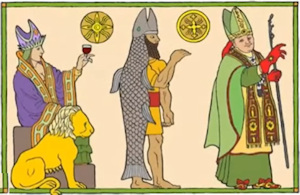
|
|
|
| |
|
|
| Saturn's Dragon storm
- a living mythtorm - |
|
|
| |
|
|
|
Pictured right is a thunderstorm on
Saturn that has remained fixed since 2004,
much to the further puzzlement of the
scientific community. Meteorologists do
not fully understand terrestial lightning,
let alone the 'surprise' of lightning on
other planets, and Saturn produces
stupendous displays!
The spiraling shape of dragons and
serpents in mythology are strikingly
similar to plasma instabilities in the
laboratory and in space, a fact which
reminds us of the metamorphosing and
life-like qualities of plasma phenomena.
It should be little surprise, then, that
we see similar configurations of
electrified plasma in megalightning on
Saturn today.
|
|
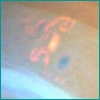 |
| |
|
|
| The Thunderbolts
of the Gods |
|
|
| |
|
|
| Varying Greek
representations of the Thunderbolts of the
Gods. |
|
|
| |
|
|
 |
|
|
| |
|
|
| Electrical discharges
(plasma thunderbolts) in the laboratory,
stylized for clarity. Is any further
explanation required in view of the striking
visual similarities? Some mental gymnastics
are required in order to dismiss these as
merely coincidental. |
|
|
| |
|
|
 |
|
|
| |
|
|
| The mythic Assyrian warrior,
Ninurta, brandishing a thunderbolt, left,
and a Greek coin, right. |
|
|
| |
|
|
 |
|

Sprites in the upper atmosphere of Earth.
|
| |
|
|
| In this close-up picture of
Ninurta wielding a thunderbolt, below, we
can also see the cosmic wheel mentioned
above, when Venus appeared as a radiant
flower in front of Saturn in the polar
configuration. It looks a bit like a wrist
watch, which some have interpreted as
evidence of advanced ancient technology.
However, this decorative symbol was
typically worn on both wrists, and very
often a headband, too. |
|
|
| |
|
|
 |
|
"...A
'derivation' of the sword from a 'root' or
archetype in lightning is universal and
world wide."
Ananada Coormaraswamy |
| |
|
|
| Odin's Thunderbolt in Norse
mythology. |
|
|
| |
|
|
 |
|
|
| |
|
|
|
Thunderbolt imagery is widespread the
world over, but few scholars and
scientists ever pause to wonder about this
ancient fascination. After all, most
contemporary researcher’s routinely
assume the old sky was essentially
identical to what we see now. As today so
before, is their default.
However, if the planets shifted on their
orbits within human memory, is it possible
that huge sparks jumped between them in
order to establish electrical equilibrium?
Were any such electrical interactions the
thunderbolts witnessed by the ancients,
and handed down via 'myth and legend'?
Again, this notion is anathema to the
gradualist paradigm. Here is a
conventional academic take:
"It should be
admitted that all of these
thunderweapons — Indian, Hittite, and
Greek — are variations of the same
basic form, a form that really looks
nothing like the thunderbolt."
R. Miller, Iconographic
Links between Indic and West Asian
Storm Gods, 2016
It is interesting that while
Miller notes the visual similarities of
thunderbolts across different cultures, and
grasps their association with lightning
(thunderstorms), he is unaware that these
thunderbolt morphologies are more or less
identical to those that have been recreated
in the laboratory. Typically, the earliest
artistic representations of a thunderbolt
are bidirectional three-pronged tridents, as
per those pictured above.
|
|
|
| |
|
|
| The Days of the Week |
|
|
| |
|
|
| It is easy to forget that
the days of the week are named after the
planets in many languages, and especially
the older languages of Latin derivation.
Some are obvious, such as Monday, short for
Moon day, Sunday, short for Sun Day, of
course, and Saturday, short for Saturn day —
the original Sabbath day. Consider the
following. |
|
|
| |
|
|
| Planets |
|
|
|
|
|
|
| Moon |
Mars |
Mercury |
Jupiter |
Venus |
Saturn |
Sun |
| Days |
|
|
|
|
|
|
| Monday |
Tuesday |
Wednesday |
Thursday |
Friday |
Saturday |
Sunday |
| French |
|
|
|
|
|
|
| Lundi |
Mardi |
Mercredii |
Jeudi |
Vendredi |
Samedi |
Dimanche |
| Spanish |
|
|
|
|
|
|
| Lunes |
Martes |
Miércoles |
Jueves |
Viernes |
Sábado |
Domingo |
| Latin diēs- |
|
|
|
|
|
|
| Lūnae |
Mārtis |
Mercuriī |
Iovis/Jovis |
Veneris |
Saturnī |
Sōlis |
| Greek Gods |
|
|
|
|
|
|
| Selene |
Ares |
Hermes |
Zeus |
Aphrodite |
Kronos |
Helios |
| Viking Gods |
|
|
|
|
|
|
| Mani |
Tyr/Tiw |
Odin/Woden |
Thor |
Frigg/Freyja |
* |
Sol |
| Swedish |
|
|
|
|
|
|
| Måndag |
Tisdag |
Onsdag |
Torsdag |
Fredag |
Lördag |
Söndag |
| Anglo-Saxon |
-dæg |
|
|
|
|
|
| Monandæg |
Tiwes- |
Wodnes- |
Ðunres- |
Frige- |
Sæternes- |
Sunnan- |
|
|
“I
conceive of nothing, in religion, science or
philosophy, that is more than the proper
thing to wear, for a while.” Charles Fort |
| |
|
|
| Hindu
astrology also uses the concept of days
under the regency of a planet. The Wikipedia
page goes into some detail on the many
associations in different languages and
cultures. It begins by saying something like
the names are derived from classical
planets in Hellenistic astrology, which
were in turn named after contemporary
deities, a system introduced by the Roman
Empire during Late Antiquity.
Planetary Gods?
Is it not possible that the names of the
gods were derived from the planets, and
not the planets from the gods? Were the
planets the gods, in other words, if they
occupied different orbits much closer to
the earth in past ages? This euhemeristic
approach would begin to explain the
commonalities across languages and
cultures. There is no doubting that the
ancients had a fascination with the
heavens. Furthermore, there are so many
key points of agreement when it comes to
the personalities ascribed to the planets
of our solar system, as described above.
Again, can over-wrought imagination alone
account for these remarkable concordances?
Please note that it is not the purpose of
this web site to promote nor denigrate any
views in respect of an intelligence behind
the universe. That's a separate
philosophical debate, and one beyond the
scope of this subject matter which falls
under the broad heading of comparative
mythology.
"The peoples of
ancient Mesoamerica keenly observed
the sky and used the calendar to
predict solar and lunar eclipses, the
cylce of the planet venus, the
apparent movements of the
constellations and other celestial
events. To them, these occurences were
not the mechanical movements of innate
celestial bodies but constituted the
activities of gods, the actual
recapitulation of mythical events from
the time of creation."
Kaule Taube, Aztec
and Maya myths, P14.
"With one voice,
every culture declared that great gods
once ruled the world, before they
departed for remote regions. Let the
world's first astronomers point the
way for us. They knew that what the
myths called Gods were planets, and
aspects of planets. Planets appeared
close to the earth in heaven spanning
configuration. Memories of that
celestial splendour still surround us,
even if humanity later forgot much
more than it remembered."
David Talbott,
comparative mythologist
|
|

Another view of Venus
within the Polar Configuration, above.
|
| An early philosophical view |
|
|
| |
|
|
|
The early Greek philosophers can be said
to provide a bridge between the old world
of 'superstition' and the new world of
'rationalism'. Both Plato and Aristotle
acknowledged that the gods were originally
astronomical bodies, and Aristotle was
proud to state it as known.
"A tradition
has been handed down by the ancient
thinkers of very early times ... to
the effect that these heavenly
bodies are Gods ... the rest of the
tradition has been added later in a
mythological form to influence the
vulgar..."
Aristotle (384 - 322 BC)
Plato (427 - 347 B.C.) also taught that
the myth of Phaeton describes real
events in nature:
[it] "really
signifies a declination of the
bodies moving in the heavens around
the earth, and a great conflagration
of things upon the earth."
|
|
“It
is one thing to show a man that he is in
error, and another to put him in possession
of truth.” John Locke |
| Conspiracy
theories |
|
|
| |
|
|
|
Conspiracy theories abound in respect of
many of the archetypal symbols mentioned
above, and it is often claimed that
certain groups secretly worship Saturn
(which they associate with 'Satanism'), or
Venus (Lucifer or the Morning Star in
western tradition). As we have seen above,
these symbols pervade modern religions and much more. Caution is obviously recommended as
many of the symbols under discussion are
ingrained in our culture and subconscious,
and are often misunderstood. At best, when
touched upon they are generally considered
an artifact of the human mind.
"The ultimate
origin of neary all folktales and
myths must remain a mystery."
Stith Thompson
Saturn is associated with the number six.
It's the sixth planet from the Sun, and it
is also associated with the black cube,
mentioned above. A cube has six sides, of
course. The hexagon pattern seen on
Saturn, below left, surprised many. Again,
caution is urged before jumping to
negative conclusions. Consider that humans
are made from carbon, for example, and
that carbon atoms comprise six irons, six
electrons, and six neutrons. Six doesn't
have to be an evil number, but anything
can be inverted.
(Numerology is an interesting but
speculative subject matter. For example:
3x6=18. 1+8=9. Nine is considered a
universal number. Nikola Tesla, of course,
was obsessed with the numbers 3, 6, and 9,
which also add up to 18, and then 9. And
so on. He is supposed to have said that 3,
6, and 9 were the key to the universe.)

The warrior or hero figure slaying or
banishing the dragon or serpent symbol is
a universal archetypal. England has St
George and the Dragon, who they share with
Georgia, and Catalonia in Spain, among
others; while Ireland has St Patrick who
rids the country of snakes; and in Norse
and Scandinavian mythology, Fáfnir (the
mythical dragon) was slain by Sigurd. The
theme is widespread. See also Ninurta
chasing Anzû with his thunderbolts,
pictured above.
The famous conspiracy theorist, David
Icke, has taken a strong interest in
Reptilian symbology, and has even gone so
far as to claim the world is secretly
ruled by reptilian hybrids. I would again
suggest, however, that the surprising
popularity of this idea owes more to the
power of the archetype than the veracity
of his theory. Mind you, in relation to
the Purple Dawn discussed above, it is
known that plants and reptiles thrive in
red/purple light. Some might like to read
into this.
Regardless, the term conspiracy theory is
much over-used today, with many now
considering it a badge of honour. On the
increasingly woeful Wikipedia, for
example, emerging paradigms like the
Electric Universe are now routinely
dismissed as pseudoscientific or
conspiratorial rather than being discussed
in any reasonable way. See here for the ancient alien
hypothesis.
|
|

"Heavenly fire is spit forth from by the
planet as crackling charcoal flies from a
burning log." Pliny, Roman naturlist
|
| |
|
|
| Graham Hancock |
|
|
| |
|
|
|
Hancock has popularised the
idea of a fallen civilisation in
prehistory, arguing that the pyramids and
a number of other structures evidence
advanced ancient cultures. Given that
Wikipedia dismiss his ideas as
pseudoscientific, they are certainly
worthy of consideration. More recently, he
has suggested that a cataclysm (most
likely a comet in his estimation) struck
the earth around 12,000 years ago, ie.,
roughly the time of the Younger Dryas, and
that this was responsible for the collapse
of the former civilisation. His ideas are
reminiscent of Atlantean myths, in other
words. The recent discovery of Göbekli
Tepe in what is now Turkey —
dated circa 9,000 BCE — has
certainly thrown conventional archaeology
a curveball. At the very least it demands
of us to question standard timelines in
terms of human history and development.
Hancock, understandably, has been quick to
highlight this.
David Talbott, by contrast
to Hancock, argues that a dramatic shift
in planetary orbits led to the earth
shattering events testified in so much
myth and legend, and catalyzed a shift in
human consciousness. This led to the
mythmaking epoch, when huge structures
arose as acts of remembrance. In short,
Talbott sees the idea of a lost
civilisation as more symbolic —
the golden age.
Perhaps these differing
views are not mutually exclusive. There is
certainly some overlap. Hancock has worked
with geologist Robert Schoch, for example,
who has spoken at an EU conference. Schoch
recognises that a lot of ancient rock art
is plasma
related. Either way, as things
stand, neither the views of Talbott nor
Hancock are acceptable to popular science
and archaeology, as per their dismissal on
Wikipedia, a web resource which few now
take seriously, anyway.
|
|
 |
| |
|
|
|
Conclusion
|
|
|
| |
|
|
|
Many mysteries remain from the mythmaking
epoch, but these begin to unravel when we
accept the likelihood of differing
planetary configurations within human
memory. Prior to this epoch, there was no
mention of time or planets. The Gods were
the planets, and this was the lost age of
innocence — the Garden of Eden.
Many cultures talk of this golden age.
After it fell apart, surivivors developed
an obsession with the planets, and
observed their every move with meticulous
accuracy as if warning us of potential
future catastrophes. Vast temples emerged
as part of this obsession. We have
forgotten more than we can remember, but
the themes and symbols remain and are
consistent. Modern doomsday anxieties, of
which there have been many, attest to
these deep rooted fears. They may also be
expressed as an irrational need not
to know.
"Contents of an
archetypal character are
manifestations of processes in the
collective unconscious. In the last
analysis, therefore, it is
impossible to say what they refer
to."
Carl Jung
While psychologists acknowledge the role
of archetypes, there has been little
interest in discovering their origins.
Their importance is recognised, while any
hope of understanding how they came about
has long since been abandoned. They just are.
Among others, does the work of David
Talbott, Dwardu Cardona, and Ev Cochrane,
on mythic themes finally shed light on the
derivation of archetypal symbols and, if
so, will any psychologists,
anthropologists, or whoever, be brave
enough to take up the gauntlet and dare to
discuss the possibility in conservative
academic circles?
|
|
|
| |
|
|
| Intellectual inertia |
 |
 |
| |
|
|
“The inertia of the human mind and
its resistance to innovation are most
clearly demonstrated not, as one might
expect, by the ignorant mass—which is
easily swayed once its imagination is
caught—but by professionals with a
vested interest in tradition and in
the monopoly of learning.
Innovation is a twofold threat to
academic mediocrities: it endangers
their oracular authority, and it
evokes the deeper fear that their
whole, laboriously constructed
intellectual edifice might
collapse. The academic
backwoodsmen have been the curse of
genius from Aristarchus to Darwin and
Freud; they stretch, a solid and
hostile phalanx of pedantic
mediocrities, across the
centuries.”
Arthur Koestler, The
Sleepwalkers [New York, 1959], p. 427.
|
|
|
|
 |
 |
|
 |
|
